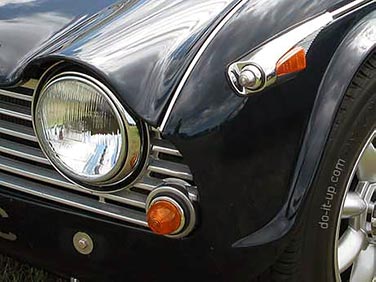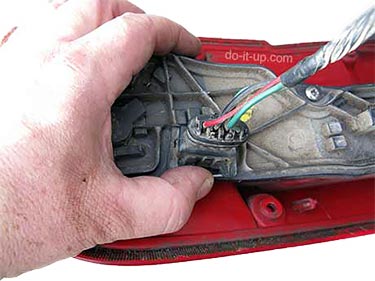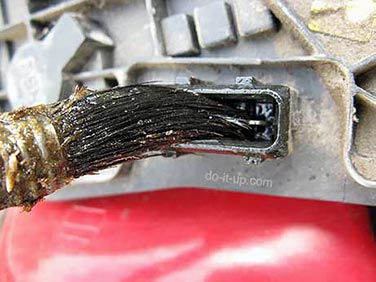How to Repair Vehicle Electrics & Lights Acting Strangely
Do you have an electrical fault on your vehicle. If you do, it can sometimes be difficult to find. This is due to the number of wires, connections and electronics in modern vehicles. This article sets out to describe some of the weird electrical faults you can find, the causes, and how you may be able to fix them…
Topics:
- The Symptoms:
- The Causes:
- Safety:
- Fault Finding:
- A Solution?
- Bad Earth or Vehicle Earth Fault:
- Hints & Tips:
- Fault Examples:
Electrical Fault Symptoms:
In this article, I am generally going to ignore issues that are caused by failure of a part, (you can change it and it’s fixed… Yey!) and concentrate on issues where it may be difficult to find the fault?
Topics:
General Faults:
If you get weird issues, where you ‘can’t find the electrical fault’, it can be quite difficult to solve. These faults can show up as a number of strange behaviours…
Such as:
- Some lights are not working?
- Dashboard warning lights are lit, for what seems, no apparent reason?
- The Intermittent operation of electrical items…
- For example, the boot lid opening, when you open the drivers door?
- Electric windows not working?
- And other weird stuff!
These faults may be due to a bad electrical connection…
- Dirty, tarnished or corroded connections.
- A broken wire, or open circuit.
- Damp ingress into electrical components.
- Or, failure of a part?
Issues When Braking or Indicating:
If you have issues when you apply the brakes, or when indicating. It could be a bad earth, (this fault may only appear when you have a trailer connected).
The fault may show up as:
- lights dimming?
- Other lights coming on?
- Side lights, reversing lights and or brake lights flashing when indicating.
The ‘bad earth‘ often occurs when the negative (-ve) return path back to the battery fails. This can be a poor connection to the vehicle bodywork. See the section on Bad Earth’s below.
Indicators Flashing too Fast?
Please see this article: My Turn Signal (Indicators) Flash Fast on One Side?
Summary:
A vehicle is not the best environment for electronic and electrical systems. They are exposed to hot and cold. Water, oils, dust and debris. As well as shock and mechanical abuse. Electrical systems need a fair bit of protection from the elements…
The Causes:
If the ‘weird electrical fault’ is not down to a defective component, it’s usually down to a bad electrical connection somewhere, a broken wire, damp ingress, etc…
General ‘Weird’ Faults, (where you can’t find anything wrong):
Unfortunately, electrical circuits in modern vehicles, aren’t always straight forward (a single wire between two points). The circuits often interact with sensors and other components on the vehicle. This can make it difficult to fault find and will often require plugging into a computer or similar device to try and find the fault.
Or, in the case of where the light’s just don’t work, it can be a suspect connection, or a broken wire. Worst case (with a modern car post 2000). A control unit is defective, or has a glitch.
Damp can also cause a multitude of faults…
A Bad Earth:
On vehicles where the bodywork is made of metal, the return path for the supply (back to the battery) is via the metal bodywork. On cars made of non-conductive materials, such as fibreglass or plastic, the return path for the supply is via a cable. Due to the bad connection(s), the electricity is trying to find its way home another way. It does this by passing through another light fitting. The lights tend to be dim because the electricity passes through more than one light bulb, a bigger load (higher resistance).

- When indicating… the flashing indicator lamp is dim and other lights (tail lights, fog lights, brake lights, etc) flash as well (sometimes very dimly)?
- When braking, the brake light is dim and other lights (tail lights, fog lights, indicator, etc) come on as well?
- If switching on a light, other lights may go off?
- The bulbs are good, but the light just doesn’t work?
- This fault can sometimes appear when connecting a trailer. The trailer can have a ‘bad earth’ which then affects the lights.
More information on a bad earth can be found below: Vehicle Earth Fault (a Solution?).
Safety
* Caution: If Disconnecting the Battery *
Do not short the battery connections, or yourself between the live supply and the earth (or bodywork). It will give you a shock! 12v is not enough voltage to kill you, (but batteries larger than 12v may be a different story). In very rare cases the battery could explode (via a spark, igniting hydrogen gas given off by the battery) sending acid and battery bits everywhere…
Also check for additional issues when disconnecting a vehicle battery, such as:
- Is a radio\entertainment center security code needed on reconnecting the battery?
- Vehicle fault code generation. E.g. If you disconnect the battery to remove a component, then reconnect the battery, before replacing the unit. It may generate a fault code. For example the entertainment unit on a Skoda also has an airbag warning light built as part of the assembly. Reconnecting the battery when the entertainment unit is disconnected, causes an airbag warning light failure error code. This error needs to be cleared by plugging in a tool to the vehicles electronics.
- Quirky vehicle specific issues, such as disconnecting the battery when an electric window is open. Having to reset the window operation. which may be an automated process (wait 5 minutes), or press the window close button for 10 seconds, (or something similar).
The vehicle handbook should advise of any vehicle specific quirks when disconnecting the battery…
More information on disconnecting a vehicle battery can be found here: Disconnecting & Removing a Vehicle Battery.
* If you are unsure about working on vehicle electrics, seek the advice of an electrical engineer *
Fault Finding (When There is Nothing Obvious)?
Topics:
For a ‘Bad Earth‘, see the section below…
The Supply is Missing?
On modern cars (post 2000) fault finding has a few more things to take into consideration. The vehicles electronics often try to be helpful, with fault codes, faulty bulb indications, etc. If there is a change in the circuit parameters, the electronics can switch off supplies if a fault is detected (protection from damaging sensitive electronics, melting wires, fire etc).
This could be why a supply is missing? Try and trace to see how far the actual supply gets. I wouldn’t be surprised if a control unit is switching off the supply because it thinks there is a fault? If the supply is off and there are no defective components, it could be a bad connection somewhere causing a change in resistance. This can flag an error code, warning light, or cause the supply to be removed, (usually by a relay somewhere).
A Bad Connection:
I have a BMW Mini that has been throwing an intermittent wobbly on the rear left hand indicator for a while. There is nothing wrong with the lamp and there is a supply present:
- Take the lamp out, put it back in.
- Swap fittings round.
- Disconnect, reconnect connectors etc.
The light works for a while (a few weeks). It then goes out and comes back with a fault indication on the dashboard? This went on for a couple of years…
In the end it was tarnishing. Tarnishing is where something loses its shine or lustre, often caused by oxidation of the surface. There is no apparent corrosion, just a slight dullness of the component. For electronics, brass and copper are good examples, where the tarnishing is sometimes a bit more visible. It can often be cleaned with an ordinary pencil rubber. But sometimes a fine scourer has to be used.
In my case, the fault was tarnishing of a galvanised circuit on the light fitting. Galvanised steel is a cheaper alternative to copper in some light fittings and is quite common these days. I cleaned the contact surface and protected it with a small amount of silicone grease, (silicone grease doesn’t destroy rubber or plastic). Vaseline can also be used if the is no rubber or plastic nearby. Don’t apply too much grease, or this will also prevent a good connection. The light has now been working for some time…
Because of the ‘modern electronics’, you may need to check all the connections in the circuit to make sure there is no added resistance (corrosion, bad contacts, etc). This type of fault can be a pain, as when you connect and disconnect the circuit, it creates a good ‘new’ connection (no fault found), but over time, days, weeks, months the fault can reappear. If you can’t find anything wrong, It can sometimes come down to slight tarnishing of any contacts, weak contact pressure (the connector), corrosion, contamination, etc. If there is a slight change in resistance values or voltages, outside of the control units parameters, the vehicle CPU can start throwing up errors!
As an example… (as a summary):
- Are the bulbs are OK.
- Check the supply at its source and along the circuit.
- Is there a fault code (it may need to be cleared).
- Check for contact resistance and open circuits (which may be intermittent), slight tarnishing, weak contact pressure, corrosion, contamination, etc.
Note:
- Disturbing components may temporarily clear any faults.
- Broken wires can be intermittent due to temperature fluctuations and movement. Carefully wiggling, wriggling, jiggling, or just plain moving the wires about, can sometimes highlight issues?
A Solution?
If there are no components that have failed, what can you do?
- Please see the Important Notes below:
- Seek out anywhere where there is a connection in the fault circuit.
- Disconnect the power.
- Carefully make and break the electrical connections anywhere there is an electrical connector.
- Try and introduce some form of electrical lubricant to aid the process. Silicone grease is good as it shouldn’t harm rubber or plastics. Don’t apply too much as it will have the opposite effect and prevent an electrical connection. The silicone grease can protect the connections from tarnishing and will make connecting and disconnecting easier.
What are we Doing Here?
Electrical connections can become tarnished over time. This is where the surface looks clean but is no longer shiny. A bit like new copper pipe losing its shine and becoming dull.
You cannot easily clean electrical connectors without taking them apart or putting them in an ultrasonic cleaner. So, by making and breaking the electrical connections, it starts to clean the surface by rubbing the connections together, (making & breaking).
Important Notes:
- This is at your own risk as electronics can be sensitive and things can break. Especially plastic, as it can become brittle.
- Disconnect any electrical supply, (check that no items are affected by this, radio codes, settings, etc). See Disconnecting & Removing a Vehicle Battery.
- Take your time and be careful.
- With connectors, make sure no pins are bent or shorted out.
- Do not power up until everything is re-connected. Other wise fault codes may be introduced that will need to be cleared.
Bad Earth or Vehicle Earth Fault:
The Solution
The solution, is to find the bad connection on the ‘return path’ of the electricity. The ‘return path’ or ‘fault path’ can be in a number of places.

- First, turn off the lights.
- Check the connections to the light fitting. Are they clean and serviceable?
- If not, carefully clean, plug the unit back in and check to see if this has cured the fault
- Still doesn’t work? Turn off the lights. Check to see if there is an earth wire (usually a wire from the light attached to the bodywork via a screw or bolt). Check the connections and clean if necessary. Connect back up and check to see if this has cured the fault?
- Still doesn’t work? Check the light bulbs, their sockets and the light fitting condition. Turn the lights on and check to see if this has cured the fault? No? Can you swap the light bulbs?
Note:
Don’t leave the wrong ‘wattage’ light bulb in the wrong socket. As this can lead to lights with the wrong brightness (one bright tail light and one dim, dim brake lights, etc, etc)
- Still doesn’t work? If the fault is with the rear lights, do you have a tow hitch? Check the tow hitch wiring and connections. Note: The tow hitch is often connected to the rear lights via plastic connectors that clamp around the existing wires and make a connection. These can become dirty and corroded, along with the tow hitch socket connections.
- Still doesn’t work? Check to see if an earth wire goes back to the battery.
- The solutions above should cure the majority of faults. If it doesn’t, seek the advice of an electrical engineer.
Hints & Tips

- Electrical connections can be protected by applying a thin coating of electrical lubricant, waxoyl etc. An electrical cleaning fluid or lubricant can improve connections by preventing oxidation and assist in cleaning where the contacts cannot be reached.
- Beware when applying oils, greases and wax, they may damage cable insulation, rubber and plastic. Read the product instructions.
- Do not get substances, dirty fingers on the light bulb glass, it will reduce their life span.
Actual Fault Examples:
(Strange things happen – With vehicle electronics)
Here’s some examples…
- My wife’s Mini – A hand brake Fault?
A fault showed intermittently on the dashboard, as a handbrake warning light and another weird warning symbol. The handbrake symbol would vary in colour (red and sometimes orange). Wandering around the vehicle, I noticed a rear side light had gone out.
I fixed the rear side light, (a bad connection to the lamp) and the dashboard errors disappeared! But it had been showing a handbrake warning?
It’s always worth looking around the vehicle for unrelated faults. They could actually be related in some way. Electronics can do strange things…
- An electronically operated boot (trunk) lid opening randomly?
On occasions, when you opened the driver’s door, the boot (trunk) lid would pop open? The rear number plate light housing (which contained a micro switch to open the boot manually) had water in it. But, what that’s got to do with the driver’s door..?
It turns out, the courtesy light (which came on when you opened the door), went to the same electronic control unit as the boot (trunk) lid switch. Light comes on > damp switch > boot opens…
Strange things definitely happen with vehicle electronics!